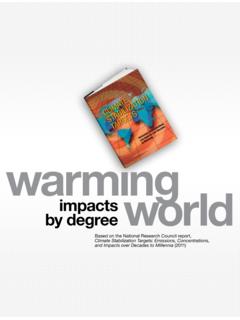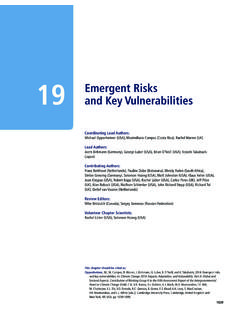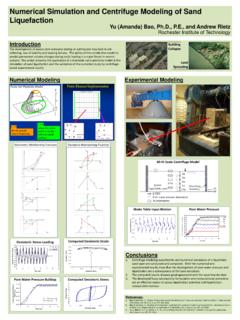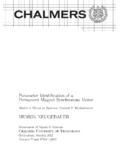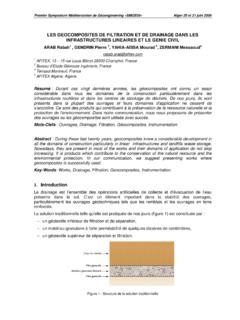Transcription of Weather as a Force Multiplier: Owning the Weather …
1 Weather as a Force Multiplier: Owning the Weather in 2025. A Research Paper Presented To Air Force 2025. by Col Tamzy J. House Lt Col James B. Near, Jr. LTC William B. Shields (USA). Maj Ronald J. Celentano Maj David M. Husband Maj Ann E. Mercer Maj James E. Pugh August 1996. Disclaimer 2025 is a study designed to comply with a directive from the chief of staff of the Air Force to examine the concepts, capabilities, and technologies the United States will require to remain the dominant air and space Force in the future. Presented on 17 June 1996, this report was produced in the Department of Defense school environment of academic freedom and in the interest of advancing concepts related to national defense. The views expressed in this report are those of the authors and do not reflect the official policy or position of the United States Air Force , Department of Defense, or the United States government.
2 This report contains fictional representations of future situations/scenarios. Any similarities to real people or events, other than those specifically cited, are unintentional and are for purposes of illustration only. This publication has been reviewed by security and policy review authorities, is unclassified, and is cleared for public release. ii Contents Chapter Page Disclaimer ..ii Executive Summary ..vi 1 2 Required Why Would We Want to Mess with the Weather ? ..3. What Do We Mean by Weather -modification ?..4. 3 System Description ..8. The Global Weather Applying Weather -modification to Military Operations ..10. 4 Concept of Operations ..13. Precipitation ..13. Exploitation of NearSpace for Space 20. Opportunities Afforded by Space 20. Communications Dominance via Ionospheric Artificial Concept of Operations 5 Investigation How Do We Get There From Here?
3 31. Conclusions ..34. Appendix Page A Why Is the Ionosphere Important? ..36. B Research to Better Understand and Predict Ionospheric C Acronyms and Definitions ..41. iii Illustrations Figure Page 3-1. Global Weather 3-2. The Military System for Weather -Modification Operations..11. 4-1. Crossed-Beam Approach for Generating an Artificial Ionospheric 23. 4-2. Artificial Ionospheric Mirrors Point-to-Point Communications ..24. 4-3. Artificial Ionospheric Mirror Over-the-Horizon Surveillance Concept..25. 4-4. Scenarios for Telecommunications Degradation ..26. 5-1. A Core Competency Road Map to Weather Modification in 2025..32. 5-2. A Systems Development Road Map to Weather Modification in Tables Table Page 1 Operational Capabilities iv Acknowledgments We express our appreciation to Mr Mike McKim of Air War College who provided a wealth of technical expertise and innovative ideas that significantly contributed to our paper.
4 We are also especially grateful for the devoted support of our families during this research project. Their understanding and patience during the demanding research period were crucial to the project's success. v Executive Summary In 2025, US aerospace forces can own the Weather by capitalizing on emerging technologies and focusing development of those technologies to war-fighting applications. Such a capability offers the war fighter tools to shape the battlespace in ways never before possible. It provides opportunities to impact operations across the full spectrum of conflict and is pertinent to all possible futures. The purpose of this paper is to outline a strategy for the use of a future Weather -modification system to achieve military objectives rather than to provide a detailed technical road map.
5 A high-risk, high-reward endeavor, Weather -modification offers a dilemma not unlike the splitting of the atom. While some segments of society will always be reluctant to examine controversial issues such as Weather -modification, the tremendous military capabilities that could result from this field are ignored at our own peril. From enhancing friendly operations or disrupting those of the enemy via small-scale tailoring of natural Weather patterns to complete dominance of global communications and counterspace control, Weather -modification offers the war fighter a wide-range of possible options to defeat or coerce an adversary. Some of the potential capabilities a Weather -modification system could provide to a war-fighting commander in chief (CINC) are listed in table 1. Technology advancements in five major areas are necessary for an integrated Weather -modification capability: (1) advanced nonlinear modeling techniques, (2) computational capability, (3) information gathering and transmission, (4) a global sensor array, and (5) Weather intervention techniques.
6 Some intervention tools exist today and others may be developed and refined in the future. vi Table 1. Operational Capabilities Matrix DEGRADE ENEMY FORCES ENHANCE FRIENDLY FORCES. Precipitation Enhancement Precipitation Avoidance - Flood Lines of Communication - Maintain/Improve LOC. - Reduce PGM/Recce Effectiveness - Maintain Visibility - Decrease Comfort Level/Morale - Maintain Comfort Level/Morale Storm Enhancement Storm Modification - Deny Operations - Choose Battlespace Environment Precipitation Denial Space Weather - Deny Fresh Water - Improve Communication Reliability - Induce Drought - Intercept Enemy Transmissions - Revitalize Space Assets Space Weather - Disrupt Communications/Radar Fog and Cloud Generation - Disable/Destroy Space Assets - Increase Concealment Fog and Cloud Removal Fog and Cloud Removal - Deny Concealment - Maintain Airfield Operations - Increase Vulnerability to PGM/Recce - Enhance PGM Effectiveness Detect Hostile Weather Activities Defend against Enemy Capabilities Current technologies that will mature over the next 30
7 Years will offer anyone who has the necessary resources the ability to modify Weather patterns and their corresponding effects, at least on the local scale. Current demographic, economic, and environmental trends will create global stresses that provide the impetus necessary for many countries or groups to turn this Weather -modification ability into a capability. In the United States, Weather -modification will likely become a part of national security policy with both domestic and international applications. Our government will pursue such a policy, depending on its interests, at various levels. These levels could include unilateral actions, participation in a security framework such as NATO, membership in an international organization such as the UN, or participation in a coalition.
8 Assuming that in 2025 our national security strategy includes Weather -modification, its use in our national military strategy will naturally follow. Besides the significant benefits an operational capability would provide, another motivation to pursue Weather -modification is to deter and counter potential adversaries. vii In this paper we show that appropriate application of Weather -modification can provide battlespace dominance to a degree never before imagined. In the future, such operations will enhance air and space 1. superiority and provide new options for battlespace shaping and battlespace awareness. The technology is 2. there, waiting for us to pull it all together; in 2025 we can Own the Weather .. Notes 1. The Weather -modification capabilities described in this paper are consistent with the operating environments and missions relevant for aerospace forces in 2025 as defined by AF/LR, a long-range planning office reporting to the CSAF [based on AF/LR PowerPoint briefing Air and Space Power Framework for Strategy Development ( )].
9 2. General Gordon R. Sullivan, Moving into the 21st Century: America's Army and Modernization, . Military Review (July 1993) quoted in Mary Ann Seagraves and Richard Szymber, Weather a Force Multiplier, Military Review, November/December 1995, 75. viii Chapter 1. Introduction Scenario: Imagine that in 2025 the US is fighting a rich, but now consolidated, politically powerful drug cartel in South America. The cartel has purchased hundreds of Russian-and Chinese-built fighters that have successfully thwarted our attempts to attack their production facilities. With their local numerical superiority and interior lines, the cartel is launching more than 10 aircraft for every one of ours. In addition, the cartel is using the French system probatoire d' observation de la terre (SPOT) positioning and tracking imagery systems, which in 2025 are capable of transmitting near-real-time, multispectral imagery with 1.
10 Meter resolution. The US wishes to engage the enemy on an uneven playing field in order to exploit the full potential of our aircraft and munitions. Meteorological analysis reveals that equatorial South America typically has afternoon thunderstorms on a daily basis throughout the year. Our intelligence has confirmed that cartel pilots are reluctant to fly in or near thunderstorms. Therefore, our Weather Force support element (WFSE), which is a part of the commander in chief's (CINC) air operations center (AOC), is tasked to forecast storm paths and trigger or intensify thunderstorm cells over critical target areas that the enemy must defend with their aircraft. Since our aircraft in 2025 have all- Weather capability, the thunderstorm threat is minimal to our forces, and we can effectively and decisively control the sky over the target.

